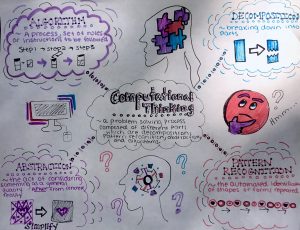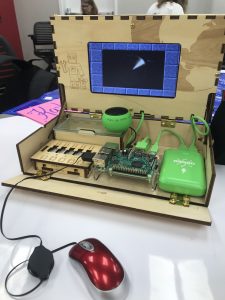Computational Thinking
In my last class in Introduction to Instructional technology for Educators, we learned about computational thinking. When I first heard of the topic, my mind immediately went to coding. Considering the last time I attempted computer coding went terribly wrong, I was beyond nervous for this class to begin. Little did I know, computational thinking encompassed much more than just coding. Computational thinking is essentially a problem solving process that is made up of many different parts. These parts include decomposition, pattern recognition, abstraction, and algorithms. Each part of computational thinking can help you when solving a problem in different, but equally effective ways.

Computational thinking represented by Kate Wehrheim
With the information we learned from class, my peers and I took on the task of building a computer. I could feel the excitement in my blood pumping as I walked into METRC library. Ms. Davis, along with other ladies who worked at METRC, passed out “Piper”computer building kits to partners around the room. Suddenly, my excitement turned into nerves as all the complicated parts of the kit were laid out before my eyes. All that my partner, Spencer, and I were given was a larger blue print of instructions and some tools. It was up to us to use what we learned about computational thinking to construct our “Piper.”
With such a daunting task ahead of us, Spencer and I applied each and every computational thinking concept we knew of. Before we began constructing our computer, Spencer and I made sure to abstract the blue print information that we did not need in order to simplify the task ahead of us. Then, Spencer and I worked together to decompose the blue print. We did this by taking apart the steps and deciding who is responsible for completing certain steps based on our strengths. Spencer handled the more complicated parts of putting together the structure, while I breezed through the basics with simple screws and knobs. Once our structure of the computer was finished, we began to play Minecraft. In the game, we followed a character named Pip Pip who provided us with certain rules to follow.  These algorithms allowed us to pass each level and move up in the game. Once we finally reached Pip Pip the mouse’s “Cheesteriod” level, Spencer and I began to recognize a pattern with the wires. Each control had a separate color, two wires, and two spaces between them. Instead of using Pip Pip’s instructions, we used pattern recognition to make an educated guess that the two last black wires went two spaces after the red wires in order to control our jumps in the game. Thankfully, we were right.
These algorithms allowed us to pass each level and move up in the game. Once we finally reached Pip Pip the mouse’s “Cheesteriod” level, Spencer and I began to recognize a pattern with the wires. Each control had a separate color, two wires, and two spaces between them. Instead of using Pip Pip’s instructions, we used pattern recognition to make an educated guess that the two last black wires went two spaces after the red wires in order to control our jumps in the game. Thankfully, we were right.
Step by step and piece by piece our computer was finally up and functioning. I didn’t realize it at the time, but all the skills I acquired about computational thinking and “the four C’s” from class were the biggest aid for this project. If it wasn’t for such easy communication with my partner, his incredible patience and understanding, and the creative aspect we each brought to the table, our computational thinking skills would be much less effective.
WATCH AND SEE!!! 
Now that I possess computational thinking skills along with the qualities of “the four C’s,” the sky is the limit for me. Whether it is everyday life, or a complicated school problem, computational thinking is always there to help. This particular skill set will be crucial in years to come. My dream is to become an elementary school teacher, and computational thinking will be a vital source in my classroom. With the world shifting constantly and advancing in technology, STEM education is becoming more prevalent. Not only will computational thinking help me to thrive in my classroom, but it will also help the students to flourish in their learning. The future lies with us and what we decide to do with the tools that are accessible now. I hope to make the best use out of computational thinking for my future, and for those who follow.
This concludes my “korner” take on computational thinking. Be sure to be on the look out for my next blog post. Until next time,
XOXO KATE